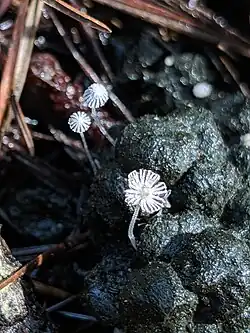Coprinopsis stercorea
| Coprinopsis stercorea | |
|---|---|

| |
| Scientific classification | |
| Kingdom: | Fungi |
| Division: | Basidiomycota |
| Class: | Agaricomycetes |
| Order: | Agaricales |
| Family: | Psathyrellaceae |
| Genus: | Coprinopsis |
| Species: | C. stercorea
|
| Binomial name | |
| Coprinopsis stercorea (Fr.) Redhead, Vilgalys & Moncalvo (2001)
| |
| Synonyms | |
| |
Coprinopsis stercorea, commonly known as the dung-loving inky cap,[1] is a species of coprophilous fungus in the family Psathyrellaceae.[2] It grows on the dung of sheep, goats and donkeys.[3]
Taxonomy
Coprinopsis stercorea was first described in 1782 as Agaricus stercoreus. Over time, it has had many different names, including Agaricus ephemerus var. stercoreus, Fungus stercoreus, and Coprinus stercoreus. In 2021, it was transferred from the genus Coprinus to Coprinopsis.[4]
Description
The cap of Coprinopsis stercorea is about 4-10 millimeters in diameter and starts out egg-shaped, before expanding and becoming flat with age. The stipe is 1-3.5 centimeters long and 0.5-1 millimeters wide.[5] The gills are adnexed and start out grayish, before turning black and deliquescing.[1] The cap can be hairy or scaly, and the stipe can be hairy or powdery.[1]
Coprinopsis stercorea is similar to several other species of inky caps, many of them only distinguishable under a microscope. C. ephemeroides resembles C. stercorea, but has a ring around the stipe.[1]
Habitat and ecology
| Coprinopsis stercorea | |
|---|---|
| Gills on hymenium | |
| Cap is ovate or flat | |
| Hymenium is adnexed | |
| Stipe is bare | |
| Ecology is saprotrophic | |
| Edibility is unknown | |
Coprinopsis stercorea is found on dung. While it usually grows on herbivore dung, it is occasionally found on dog and bear dung.[1]
See also
References
- ^ a b c d e Siegel, Noah; Schwarz, Christian (1 September 2024). Mushrooms of Cascadia: A Comprehensive Guide to Fungi of the Pacific Northwest. Humboldt County, California: Backcountry Press. p. 96. ISBN 9781941624197.
- ^ "Coprinopsis stercorea". Global Biodiversity Information Facility. Retrieved 12 May 2022.
- ^ Richardson, Michael J. (2008). "Coprophilous fungi from the Greek Aegean islands" (PDF). Mycologia Balcanica. 5: 23–32.
- ^ "Coprinopsis stercorea". www.mycobank.org. Retrieved 20 August 2025.
- ^ Wood, Michael. "California Fungi: Coprinopsis stercorea". www.mykoweb.com. Retrieved 20 August 2025.